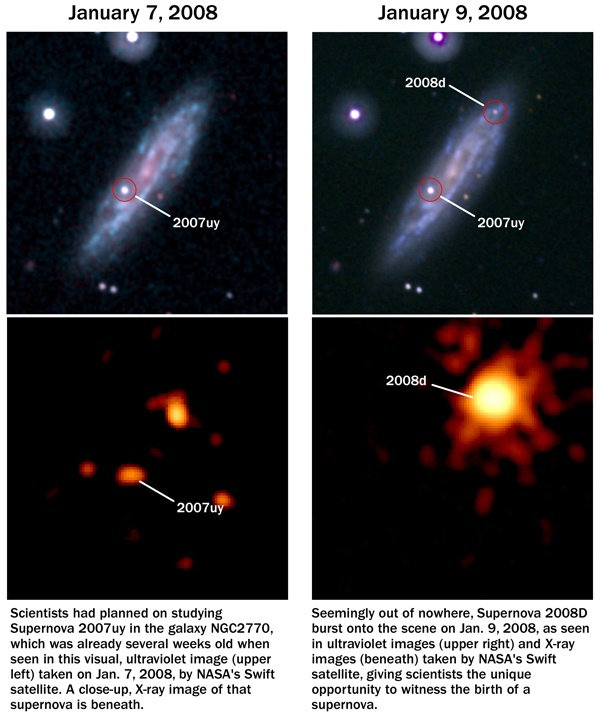
Have you heard the news? Astronomers have observed the early phase of an exploding star. It’s 2008d, the “supernova caught in the act.”
If you are in the science media, you can’t help having heard about it. For days, we’ve been in the midst of a blitz that would make the Luftwaffe envious. Fortunately, the supernova discoverers are firing press releases at us, not dropping bombs.
At one point yesterday, I almost reached for my spam filter. As is often the case, multiple scientists had a hand in the discovery. And the home institution of each and every one thought it prudent to mass-distribute a press release. The basic information was the same, with the addition of extra detail about the various scientists. I counter 11 separate press releases floating around, including one in Chinese from the National Tsing Hua University in Taiwan.
As if that weren’t enough, today at noon EST, Princeton University — home base for astronomer Alicia Soderberg, who made the discovery — held a live teleconference. For all the hoopla, you’d think somebody at Princeton invented a better mousetrap.
My gut reaction to this is it’s just a bit much. At the press briefing earlier today, Soderberg spoke of a “thrilling and historic event.” And the SN2008d blitz comes fast on the heels of NASA’s campaign to promote G1.9+03, the youngest Milky Way supernova remnant known. It exploded in 1868.
NASA announced a press conference 1 week ahead of time, pitching it as the “discovery of an object in our galaxy astronomers have been hunting for more than 50 years.”
Um ... sort of. In keeping with estimates of the rate of star birth and death in the galaxy, we should see a certain number of supernova remnants in the Milky Way. The discovery of G1.9+03 supports current estimates.
But the wording in the NASA release suggested astronomers had been doggedly pursuing a particular object — not just any supernova. This feels like a bait and switch maneuver.
Don’t get me wrong: I think it’s wonderful that astronomers have discovered a 140-year-old supernova in the Milky Way and observed a star in the act of exploding. The latter is going to thrill supernova theorists and computer modelers. It also provides the science media a story with wide public appeal.
But let’s not overdo it. Until more substantial findings dribble out in the journals, this is just another biggest/loudest/fastest/firstest/youngest/oldest science discovery headline story. Sending out eleven press releases doesn’t change that. And don’t forget that overselling a story can have consequences — the infamous “boy who cried wolf” effect.
Here’s a lesser-known fact about SN2008d: It’s not news. On February 5, the astronomers posted their discovery on the arXiv server, a place on the Internet where scientists disseminate their research before official publication.
Ron Cowan, the enterprising astronomy editor of Science News, reads arXiv server. He posted a story about SN2008d on March 5, noting that the scientists would not comment on the research.
Why? Because they had submitted their report to the British journal Nature. And Nature enforces a strict embargo — an impolite person might call it a gag order — forbidding scientists to discuss their own research with reporters. Many of us strongly suspect part of the motivation for the gag order is to exert maximum control over the media process, to make the biggest splash possible — and hopefully leave its rival, the journal Science, all wet. (The paper on SN2008d appears in tomorrow’s issue of Nature, by the way.)
The media blitz by Princeton is also an attempt to shape and control the media. Fortunately for them, we are willing and enthusiastic participants most of the time — as long as they send us cool color images.
The script plays out the same way every time. Announce a major discovery without releasing any images. Then schedule a dramatic moment, like a press conference. That way, the story goes out on the wires at about the same time all over the world, creating the illusion this story is “breaking news.” But anyone who follows the arXiv server knows it is not quite the case.